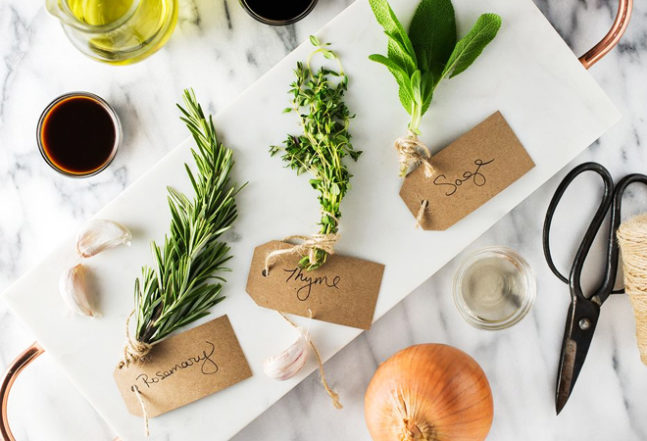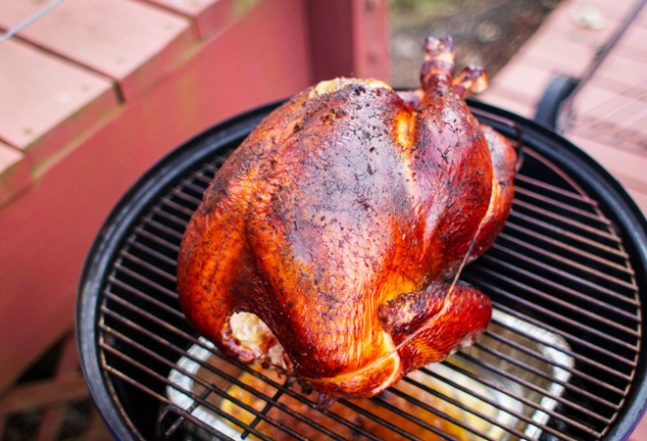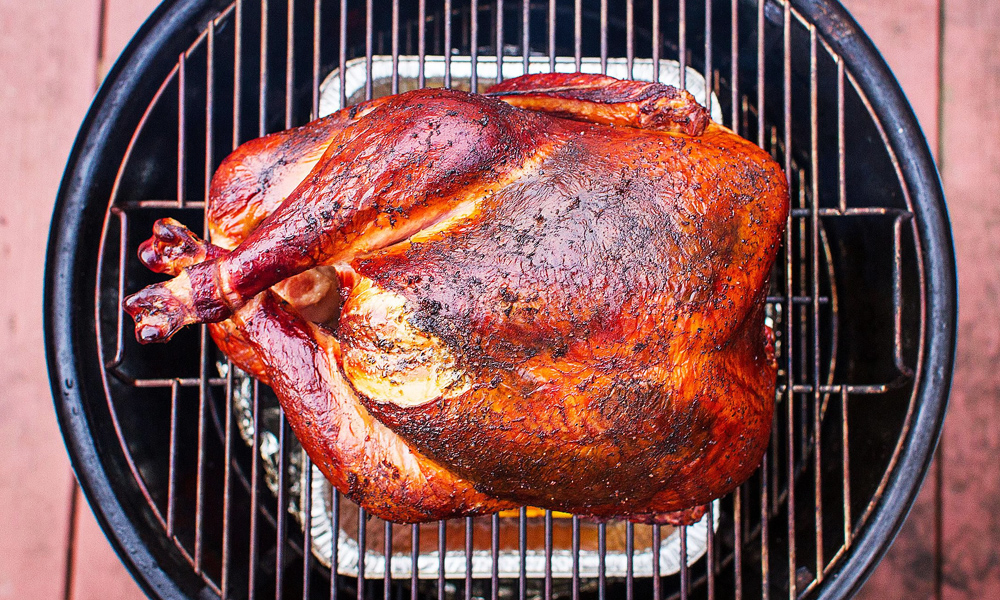In the next few days, millions of backyard master chefs, pitmasters, and fry cooks all over the country are going to cook what they undoubtedly believe is the hands-down best turkey ever carved up and served on a platter. Someone’s going to be right, but we’ll never know who, because there’s no official running for “Best Thanksgiving Bird of 2017” award.
What we do know is that Thanksgiving allows us to flex our culinary expertise. We’re all competing for the title, and even though we’ll never know the winner, we’ll be damn sure we’re worthy contenders. Let’s make sure you are too. You’ve undoubtedly roasted your Thanksgiving turkey, and you may have even deep fried one, too. But have you tried your hand at smoking it?

Why Smoke?
Before we dive head first into how, we feel it’s necessary to explain why. Of all the ways to cook your turkey, why should you spend a whole day smoking a bird when you can roast one in half the time, deep fry one in a fraction, and end up with a delectable dinner that kicks ass no matter what?
Those are valid questions. Smoking takes a lot of time, care, and patience to get right. It’s a serious labor of love, but we’re confident in saying the juice is worth the squeeze.
First of all, “smoked turkey” is basically synonymous with “barbecue turkey,” and if you know anything about anything, you know that barbecue anything is the best of everything. You dig? Are you picking up what we’re putting down, Aunt Jemima? Good. Keep following along!
If you’re not sure what smoking is, you can read more about it here. Basically, it’s a process that involves slowly—very very slowly—cooking your turkey over wood chips and hot coals. Aside from the incredible flavor, the low-and-slow process also naturally tenderizes the meat, making it succulent, a little sweet, a little smoky, a little savory, and a little spicy. There’s honestly nothing like it.
The best way to describe it that we’ve read comes from the folks over at Tasty Meat, in an article in which the team—comprised of chefs, pitmasters, and grill experts—discusses their favorite meats to smoke:
“Smoked turkey has a delectably moist and firm texture, and a creamy-sweet taste that takes on the flavor of your smoke wood, with complex overtones. The aroma alone is worth the extra trouble.”
They ain’t lyin’, that’s for sure.

What You’ll Need
People tend to shy away from smoking because they think they’re going to need a bunch of fancy schmancy equipment to make it happen, but that’s simply not true. A smoker is obviously great if you can get your hands on a good one, and the options there are plentiful. You can go with a standard charcoal smoker like this Weber or this one from Cuisinart. You can also grab an electric smoker, a propane smoker, or a pellet grill smoker, depending on what you have available. Hell, if you know what you’re doing, you could even smoke on a standard charcoal grill. You’ll have to be careful, and you’ll need to work with a smaller bird, but we’ve seen it done.
Other than that, all you’ll need is some charcoal as a heat source, wood chips of your choice, a basting brush, a meat thermometer, and a prepped turkey. Oh, and a nice cold beer or ten.

The Importance of the Brine
How you choose to prep your turkey is going to rely a lot on personal preference. Some people prefer to let the wood chips work their magic in determining flavor, while others don’t mind helping things along with seasonings, rubs, and basting.
But before we get into that, it’s important to note that smoking is a really harsh cooking process that, by design, draws moisture out of meat. So, if you’re goal isn’t serving up a dried out piece of tree bark for Thanksgiving dinner this year, brining is going to be essential. We won’t get into the science of it (for that, you can go here), but basically, brining helps draw moisture—and spices, if you choose—into the meat, so that it doesn’t dry out during the long, intense smoking process. Long story short, it’s essential.
Whether you’re roasting, smoking, or deep-frying your bird, the brining process is universal. This guide from Allrecipes.com includes an explainer, infographic, and a video for those of us who need a thorough learning experience. The “Mix and Match” part of the infographic is an excellent resource to help you add a bit of flavor to your brine without getting overbearing or conflicting. This brine recipe is also a proven standard, and this maple brine sounds absolutely delicious. It’s all up to your preference.

Prepping the Bird
The additional prepping you do on your bird really all depends on how you went about brining it. If you did just a basic salt-water brine, use the time after brining to get creative and add some much-needed flavor to the equation. The turkey will pick up a lot of the smoke from the wood chips, but it’ll still need help if you want to really “wow” people with it. This roundup of turkey rubs is excellent, but this garlic butter rub might be our favorite.
Far as physical prep goes, it’s pretty straightforward. Remove the neck and giblets, trim the loose pieces of skin, and then tie or pin down the wings and other loose ends (they tend to overcook if left to dangle). From there, it’s all about applying the rub of your choice.
A quick pro-tip from Bobby Flay: No matter what you’re doing, always brush on a thin coat of canola oil to help your rub stay put.

Selecting the Right Wood Chips
The best part about cooking with wood chips is that it’s not an exact science. You can select whichever types you want. Classically sweeter, more mild woods—like cherry, maple, apple, peach, etc.—work excellently with turkey because it’s a lighter, more mild type of meat that could be overpowered by smokier chips like mesquite or hickory. You can mix and match whatever you’d like, but just keep the lightness of turkey in mind. If you want a guide to the different types of wood chips and what they pair well with, check out this guide from The Grillin’ Fools.
Whatever you choose, just do yourself a favor and make sure you soak them in water for at least four hours before you toss them in the smoker. You don’t want them to burn up; you want them to cook and slowly release the flavor that’s going to soak into your turkey.

Finally—Smoking Your Bird
Remember what we said up top about this being a labor of love? Yeah, we meant it.
The good news is you’ve, brined your bird, applied your rub, done all the prep work, got the smoker going, and now you’re ready to toss this sucker in.
If you’re tired of reading, just go check out the Bobby Flay video we linked above (or here, for your convenience). He goes through all of the extra steps and there’s a detailed write up to follow.
Flay uses a delicious baste that you’re free to work with (or not), but either way you cut it, remember:
- Keep your smoker at 275 degrees Fahrenheit.
- Expect anywhere from 3.5 to 6 hours of cook time, depending on the size of your turkey.
- Check doneness in the thigh and breast; should measure in at 160 degrees Fahrenheit.
- Always let your turkey rest for 20 minutes before carving it.
Enjoy!




